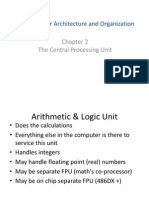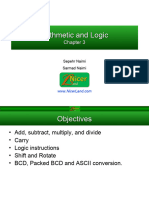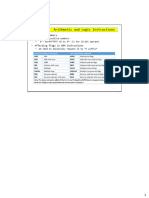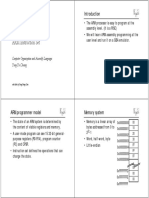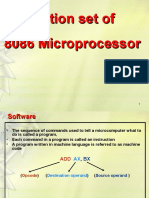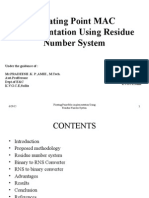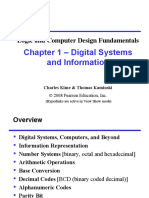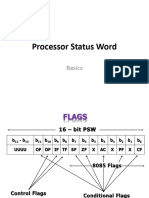Lecture 4: ARM Arithmetic and Bitweise
Instructions
CSE 30: Computer Organization and Systems Programming
Diba Mirza
Dept. of Computer Science and Engineering
University of California, San Diego
Basic Types of ARM Instructions
1. Arithmetic: Only processor and registers involved
1. compute the sum (or difference) of two registers, store the
result in a register
2. move the contents of one register to another
2. Data Transfer Instructions: Interacts with memory
1. load a word from memory into a register
2. store the contents of a register into a memory word
3. Control Transfer Instructions: Change flow of execution
1. jump to another instruction
2. conditional jump (e.g., branch if registeri == 0)
3. jump to a subroutine
ARM Addition and Subtraction
§ Syntax of Instructions:
1 2, 3, 4
where:
1) instruction by name
2) operand getting result (“destination”)
3) 1st operand for operation (“source1”)
4) 2nd operand for operation (“source2”)
§ Syntax is rigid (for the most part):
§ 1 operator, 3 operands
§ Why? Keep Hardware simple via regularity
Addition and Subtraction of Integers
§ Addition in Assembly
§Example: ADD r0,r1,r2 (in ARM)
Equivalent to: a = b + c (in C)
where ARM registers r0,r1,r2 are associated
with C variables a, b, c
§ Subtraction in Assembly
§Example: SUB r3, r4, r5 (in ARM)
Equivalent to: d = e - f (in C)
where ARM registers r3,r4,r5 are associated
with C variables d, e, f
Setting condition bits
§ Simply add an ‘S’ following the arithmetic/
logic instruction
§Example: ADDS r0,r1,r2 (in ARM)
This is equivalent to r0=r1+r2 and set the
condition bits for this operation
What is the min. number of assembly
instructions needed to perform the following ?
a = b + c + d - e;
A. Single instruction
B. Two instructions
C. Three instructions
D. Four instructions
Assume the value of each variable is stored in a
register.
What is the min. number of assembly
instructions needed to perform the following ?
a = b + c + d - e;
A. Single instruction
B. Two instructions
C. Three instructions
D. Four instructions
Assume the value of each variable is stored in a
register.
Addition and Subtraction of Integers
§ How do the following C statement?
a = b + c + d - e;
§ Break into multiple instructions
§ ADD r0, r1, r2 ; a = b + c
§ ADD r0, r0, r3 ; a = a + d
§ SUB r0, r0, r4 ; a = a - e
§ Notice: A single line of C may break up into
several lines of ARM.
§ Notice: Everything after the semicolon on
each line is ignored (comments)
Addition and Subtraction of Integers
§ How do we do this?
§ f = (g + h) - (i + j);
§ Use intermediate temporary register
ADD r0,r1,r2 ; f = g + h
ADD r5,r3,r4 ; temp = i + j
SUB r0,r0,r5 ; f =(g+h)-(i+j)
Immediates
§ Immediates are numerical constants.
§ They appear often in code, so there are ways
to indicate their existence
§ Add Immediate:
§ f = g + 10 (in C)
§ ADD r0,r1,#10 (in ARM)
§ where ARM registers r0,r1 are associated
with C variables f, g
§ Syntax similar to add instruction, except
that last argument is a #number instead of a
register.
Arithmetic operations: Addressing Modes
1. Register Direct Addressing: Operand values are
in registers:
v ADD r3, r0, r1; r3=r0+r1
2. Immediate Addressing Mode: Operand value is
within the instruction
v ADD r3, r0, #7; r3=r0+7
v The number 7 is stored as part of the instruction
3. Register direct with shift or rotate (more next
lecture)
v ADD r3, r0, r1, LSL#2; r3=r0+ r1<<2
What is a likely range for immediates in
the immediate addressing mode
A. 0 to (232-1)
B. 0 to 255
What is a likely range for immediates in
the immediate addressing mode
A. 0 to (232-1)
B. 0 to 255 Immediates are part of the instruction
(which is a total of 32 bits). Number of bits
reserved for representing immediates is 8 bits
Add/Subtract instructions
1. ADD r1, r2, r3; r1=r2+r3
2. ADC r1, r2, r3; r1=r2+r3+ C(arry Flag)
3. SUB r1, r2,r3; r1=r2-r3
4. SUBC r1, r2, r3; r1=r2-r3 +C -1
5. RSB r1, r2, r3; r1= r3-r2;
6. RSC r1, r2, r3; r1=r3-r2 +C -1
Integer Multiplication
vPaper and pencil example (unsigned):
Multiplicand 1000
Multiplier x1001
1000
0000
0000
+1000
01001000
vm bits x n bits = m + n bit product
Multiplication
§ Example:
§ in C: a = b * c;
§ in ARM:
let b be r2; let c be r3; and let a be r0 and r1 (since it may be up to 64 bits)
MUL r0, r2, r3 ; b*c only 32 bits stored
Note: Often, we only care about the lower half of the product.
SMULL r0,r1,r2,r3 ; 64 bits in r0:r1
Multiply and Divide
§ There are 2 classes of multiply - producing 32-bit and 64-bit results
§ 32-bit versions on an ARM7TDMI will execute in 2 - 5 cycles
§ MUL r0, r1, r2 ; r0 = r1 * r2
§ MLA r0, r1, r2, r3 ; r0 = (r1 * r2) + r3
§ 64-bit multiply instructions offer both signed and unsigned versions
§ For these instruction there are 2 destination registers
§ [U|S]MULL r4, r5, r2, r3 ; r5:r4 = r2 * r3
§ [U|S]MLAL r4, r5, r2, r3 ; r5:r4 = (r2 * r3) + r5:r4
§ Most ARM cores do not offer integer divide instructions
§ Division operations will be performed by C library routines or inline shifts
Logical Operations operate on
A. Bits
B. Instructions
C. Numbers
D. Strings
18
Logical Operations operate on
A. Bits
B. Instructions
C. Numbers
D. Strings
19
Logical Operators
vBasic logical operators:
vAND
vOR
vXOR
vBIC (Bit Clear)
vIngeneral, can define them to accept >2 inputs,
but in the case of ARM assembly, both of these
accept exactly 2 inputs and produce 1 output
vAgain, rigid syntax, simpler hardware
20
Logical Operators
vTruth Table: standard table listing all possible
combinations of inputs and resultant output for each
vTruth Table for AND, OR and XOR
A AND (NOT B)
A B A AND B A OR B A XOR B A BIC B
0 0 !! 0! 0! 0! 0!
!0
! 1! 0! 1! 1! 0!
!1 0! 0! 1! 1! 1!
!1 1! 1! 1! 0! 0!
21
Bitwise Logic Instruction Syntax
vSyntax of Instructions:
1 2, 3, 4
where:
1) instruction by name
2) operand getting result (“destination”)
3) 1st operand for operation (“source1”)
4) 2nd operand for operation (“source2”)
vSyntax is rigid (for the most part):
v1operator, 3 operands
vWhy? Keep Hardware simple via regularity
22
Bitwise Logic Operations
vBitwise AND in Assembly
vExample: AND r0,r1,r2 (in ARM)
Equivalent to: r0 = r1 & r2 (in C)
vBitwise OR in Assembly
vExample: ORR r3, r4, r5 (in ARM)
Equivalent to: r3 = r4 | r5 (in C)
vBitwise XOR in Assembly
vExample: EOR r0,r1,r2 (in ARM)
Equivalent to: r0 = r1 ^ r2 (in C)
vBitwise Clear in Assembly
vExample: BIC r3, r4, r5 (in ARM)
Equivalent to: r3 = r4 & (!r5) (in C)
23
Bit wise operations
r0: 01101001
r1: 11000111
__________
ORR r3, r0,r1; r3: 11101111
AND r3,r0,r1; r3: 01000001
EOR r3,r0,r1; r3: 10101110
BIC r3, r0, r1; r3: 00101000
24
Uses for Logical Operators
vNote that ANDing a bit with 0 produces a 0 at the
output while ANDing a bit with 1 produces the
original bit.
vThis can be used to create a mask.
vExample:
1011 0110 1010 0100 0011 1101 1001 1010
mask:! 0000 0000 0000 0000 0000 1111 1111 1111
vThe result of ANDing these:
0000 0000 0000 0000 0000 1101 1001 1010
mask last 12 bits!
25
Uses for Logical Operators
vSimilarly, note that ORing a bit with 1
produces a 1 at the output while ORing a bit
with 0 produces the original bit.
vThis can be used to force certain bits of a
string to 1s.
vFor example, 0x12345678 OR 0x0000FFF
results in 0x1234FFFF (e.g. the high-order 16
bits are untouched, while the low-order 16 bits
are forced to 1s).
26
Invert bits 0-2 of x
A. x AND 00000111
B. x OR 00000111
C. x MOVN 00000111
D. x XOR 00000111
27
Invert bits 0-2 of x
A. x AND 00000111
B. x OR 00000111
C. x MOVN 00000111
D. x XOR 00000111
28
Uses for Logical Operators
vFinally, note that BICing a bit with 1 resets
the bit (sets to 0) at the output while BICing
a bit with 0 produces the original bit.
vThis can be used to force certain bits of a
string to 0s.
vFor example, 0x12345678 OR 0x0000FFFF
results in 0x12340000 (e.g. the high-order 16
bits are untouched, while the low-order 16 bits
are forced to 0s).
29
Find the 1's complement of x
A. x XOR 00000000
B. x XOR 11111111
C. x XOR 11111110
D. x BIC 11111111
30
Find the 1's complement of x
A. x XOR 00000000
B. x XOR 11111111
C. x XOR 11111110
D. x BIC 11111111
31
Assignment Instructions
v Assignment in Assembly
vExample: MOV r0,r1 (in ARM)
Equivalent to: a = b (in C)
where ARM registers r0, r1 are associated with C
variables a & b
vExample: MOV r0,#10 (in ARM)
Equivalent to: a = 10 (in C)
32
Assignment Instructions
v MVN – Move Negative – moves one’s
complement of the operand into the register.
v Assignment in Assembly
vExample: MVN r0,#0 (in ARM)
Equivalent to: a = -1 (in C)
where ARM registers r0 are associated with C
variables a
Since ~0x00000000 == 0xFFFFFFFF
33
Shifts and Rotates
v LSL – logical shift by n bits – multiplication by 2n
C … 0
v LSR – logical shift by n bits – unsigned division by 2n
0 … C
v ASR – arithmetic shift by n bits – signed division by 2n
… C
v ROR – logical rotate by n bits – 32 bit rotate
… C
34
01101001 << 2
A. 00011010
B. 00101001
C. 01101001
D. 10100100
35
A new instruction HEXSHIFTRIGHT shifts hex
numbers over by a digit to the right.
HEXSHIFTRIGHT i times is equivalent to
A. Dividing by i
B. Dividing by 2i
C. Dividing by 16i
D. Multiplying by 16i
36
A new instruction HEXSHIFTRIGHT shifts hex
numbers over by a digit to the right.
HEXSHIFTRIGHT i times is equivalent to
A. Dividing by i
B. Dividing by 2i
C. Dividing by 16i
D. Multiplying by 16i
37
Ways of specifying operand 2
v Opcode Destination, Operand_1, Operand_2
v Register Direct: ADD r0, r1, r2;
v With shift/rotate:
1) Shift value: 5 bit immediate (unsigned integer)
ADD r0, r1, r2, LSL #2; r0=r1+r2<<2; r0=r1+4*r2
2) Shift value: Lower Byte of register:
ADD r0, r1, r2, LSL r3; r0=r1+r2<<r3; r0=r1+(2^r3)*r2
v Immediate: ADD r0, r1, #0xFF
v Withrotate-right ADD r0,r1, #0xFF, 28
Rotate value must be even: #0xFF ROR 28 generates:
0XFF00000000
38
Ways of specifying operand 2
v Opcode Destination, Operand_1, Operand_2
v Register Direct: ADD r0, r1, r2;
v With shift/rotate:
1) Shift value: 5 bit immediate (unsigned integer)
ADD r0, r1, r2, LSL #2; r0=r1+r2<<2; r0=r1+4*r2
2) Shift value: Lower Byte of register:
ADD r0, r1, r2, LSL r3; r0=r1+r2<<r3; r0=r1+(2^r3)*r2
v Immediate addressing: ADD r0, r1, #0xFF
v 8 bit immediate value
v With rotate-right ADD r0,r1, #0xFF, 8
§ Rotate value must be even
#0xFF ROR 8 generates: 0XFF000000
§ Maximum rotate value is 30
39
Reasons for constraints on Immediate Addressing
v The data processing instruction format has 12 bits
available for operand2
11 8 7 0
rot immed_8
0xFF000000
x2
Shifter MOV r0, #0xFF,8
ROR
Immed_8=0xFF, rot =4
v 4bit rotate value (0-15) is multiplied by two to
give range 0-30 in steps of 2
v Rule to remember is “8-bits rotated right by an
even number of bit positions”
40
Generating Constants using immediates
Rotate Value Binary Decimal Hexadecimal
0 000000000000000000000000xxxxxxxx 0-255 0-0xFF
Right, 30 bits 0000000000000000000000xxxxxxxx00 4-1020 0x4-0x3FC
Right, 28 bits 00000000000000000000xxxxxxxx0000 16-4080 0x10-0xFF0
Right, 26 bits 000000000000000000xxxxxxxx000000 128-16320 0x40-0x3FC0
… … … …
Right, 8 bits xxxxxxxx000000000000000000000000 16777216- 0x1000000-0xF
255x224 F000000
Right, 6 bits xxxxxx0000000000000000000000xx - -
Right, 4 bits xxxx0000000000000000000000xxxx - -
Right, 2 bits xx0000000000000000000000xxxxxx - -
v This scheme can generate a lot, but not all, constants.
v Others must be done using literal pools (more on that later)
41
Implementation in h/w using a Barrel Shifter
Operand 1 Operand 2 1. Register, optionally with shift operation
v Shift value can either be:
v 5 bit unsigned integer
v Specified in bottom byte of
Barrel another register.
Shifter
v Used for multiplication by constant
2. Immediate value
v 8 bit number, with a range of 0-255.
v Rotated right through even
ALU number of positions
v Allows increased range of 32-bit
constants to be loaded directly into
registers
Result
42
Shifts and Rotates
v Shifting in Assembly
Examples:
MOV r4, r6, LSL #4 ; r4 = r6 << 4
MOV r4, r6, LSR #8 ; r4 = r6 >> 8
v Rotating in Assembly
Examples:
MOV r4, r6, ROR #12
; r4 = r6 rotated right 12 bits
; r4 = r6 rotated left by 20 bits (32 -12)
Therefore no need for rotate left.
43
Variable Shifts and Rotates
v Alsopossible to shift by the value of a register
v Examples:
MOV r4, r6, LSL r3
; r4 = r6 << value specified in r3
MOV r4, r6, LSR #8 ; r4 = r6 >> 8
v Rotating in Assembly
vExamples:
MOV r4, r6, ROR r3
; r4 = r6 rotated right by value specified
in r3
44
Constant Multiplication
v Constant multiplication is often faster using shifts and
additions
MUL r0, r2, #8 ; r0 = r2 * 8
Is the same as:
MOV r0, r2, LSL #3 ; r0 = r2 * 8
v Constant division
MOV r1, r3, ASR #7 ; r1 = r3/128
Treats the register value like signed values (shifts in MSB).
Vs.
MOV r1, r3, LSR #7 ; r1 = r3/128
Treats register value like unsigned values (shifts in 0)
45
Constant Multiplication
v Constant multiplication with subtractions
MUL r0, r2, #7 ; r0 = r2 * 7
Is the same as:
RSB r0, r2, r2, LSL #3 ; r0 = r2 * 7
; r0 = -r2 + 8*r2 = 7*r2
RSB r0, r1, r2 is the same as
SUB r0, r2, r1 ; r0 = r1 – r2
Multiply by 35:
ADD r9,r8,r8,LSL #2 ; r9=r8*5
RSB r10,r9,r9,LSL #3 ; r10=r9*7
Why have RSB? B/C only the second source operand can be shifted. 46
Conclusion
vInstructions so far:
vPreviously:
ADD, SUB, MUL, MLA, [U|S]MULL, [U|S]MLAL
vNew instructions:
RSB
AND, ORR, EOR, BIC
MOV, MVN
LSL, LSR, ASR, ROR
vShifting can only be done on the second source operand
vConstant multiplications possible using shifts and
addition/subtractions
47
Comments in Assembly
§ Another way to make your code more
readable: comments!
§ Semicolon (;) is used for ARM comments
§ anything from semicolon to end of line is a
comment and will be ignored
§ Note: Different from C
§ C comments have format /* comment */, so
they can span many lines
Conclusion
§ In ARM Assembly Language:
§ Registers replace C variables
§ One Instruction (simple operation) per line
§ Simpler is Better
§ Smaller is Faster
§ Instructions so far:
§ ADD, SUB, MUL, MULA, [U|S]MULL, [U|
S]MLAL
§ Registers:
§ Places for general variables: r0-r12





